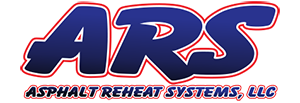Decorative Asphalt
Make your asphalt stand out and be noticed.
Stamped asphalt application is the printing of patterns (typically brick) into the surface of warm asphalt, giving the pavement an authentic brick appearance. The printed pattern is usually given a custom color coating to enhance the pattern’s overall appeal.
Using an ARS manufactured Heater to reheat and stamp the existing asphalt eliminates many factors that complicate the traditional hot printing process.
- When using the reheat process for stamped asphalt, lengthy jobs or cool days are no longer interrupting factors.
- Your two or three man printing crew is never delayed or pressured by the activities of the paving crew.
- They can simply heat a section, stamp the patterned asphalt design, and move to the next area at their own pace.
- On a typical job, a crew should be able to print and apply a color coating to an entire project, completing the job in one day.


Reduce labor and equipment costs
Our Infrared Heater requires very little knowledge of asphalt, as it is performed independently of the paving process. The labor and equipment necessary for this method is considerably less than the traditional methods, which involves an entire paving crew along with their additional trucks and rollers.
The only equipment required for the reheat method is:
- One vehicle
- One heater
- One compactor
- A couple grid patterns and
- Possibly a spray coating unit
Infrared Thermoplastic
Thermoplastic heaters will provide a nice even surface, which is ideal for standard road markings, turn arrows, stop bars and decorative designs (logos, crosswalks, inlaid patterns, etc.).


Infrared Stamped Asphalt
The process of stamping asphalt is now open to an entirely new market with the use asphalt reheating methods. Any asphalt pavement in good condition is a good candidate for infrared patterned asphalt. The color coatings you choose will not only give the project a unique look but will also extend the life of the asphalt. This method also provides a cost-effective alternative in traffic calming, hill traction, and drainage problems.

